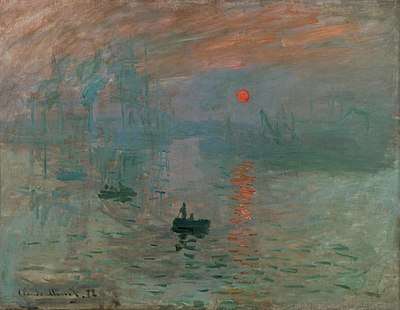American Impressionism
American Impressionism was a style of painting related to European Impressionism and practiced by American artists in the United States during the late 19th and early 20th centuries. American Impressionism is a style of painting characterized by loose brushwork and vivid colors. The style often depicted landscapes mixed with scenes of upper-class domestic life.

Emerging style
.jpg)
Impressionism emerged as an artistic style in France in the 1860s. Major exhibitions of French impressionist works in Boston and New York in the 1880s introduced the style to the American public. Some of the first American artists to paint in an impressionistic mode, such as Theodore Robinson and Mary Cassatt, did so in the late 1880s after visiting France and meeting with artists such as Claude Monet. Others, such as Childe Hassam, took notice of the increasing numbers of French impressionist works at American exhibitions.
Impressionism in the Industrial Age
As railroads, automobiles, and other new technology emerged, American impressionists often painted vast landscapes and small towns in an effort to return to nature. Before the invention of collapsible paint tubes artists were often confined to using subjects in their studios or painting from memory. With the invention of paint tubes in 1841, artists could transport their paint and easily paint in nature.
Trailblazers
From the 1890s through the 1910s, American impressionism flourished in art colonies—loosely affiliated groups of artists who lived and worked together and shared a common aesthetic vision. Art colonies tended to form in small towns that provided affordable living, abundant scenery for painting, and relatively easy access to large cities where artists could sell their work. Some of the most important American impressionist artists gathered at Cos Cob and Old Lyme, Connecticut, both on Long Island Sound; New Hope, Pennsylvania, on the Delaware River; and Brown County, Indiana. American impressionist artists also thrived in California at Carmel and Laguna Beach; in New York on eastern Long Island at Shinnecock, largely due to the influence of William Merritt Chase; and in Boston where Edmund Charles Tarbell and Frank Weston Benson became important practitioners of the impressionist style.
Jazz Age decline
Some American art colonies remained vibrant centers of impressionist art into the 1920s. However, impressionism in America lost its cutting-edge status in 1913 when a historic exhibition of modern art took place at the 69th Regiment Armory building in New York City. The “Armory Show”, as it came to be called, heralded a new painting style regarded as more in touch with the increasingly fast-paced and chaotic world, especially with the outbreak of World War I, The Great Depression and World War II.
Characteristics of American Impressionism
Unlike early Renaissance painters, American Impressionists favored asymmetrical composition, cropped figures, and plunging perspectives in their works in order to create a more "impressionist" version of the subject. In addition, American impressionists used pure color straight from the tubes to make the works more vibrant, used broken brushstrokes, and practiced "impasto"- a style of painting characterized by thick raised strokes. European impressionists painted tranquil scenes of landscapes or the lower and middle classes. American impressionists focused on landscapes like the European impressionists, but unlike their European counterparts, American impressionists painted scenes that depicted the upper class in an effort to show off America's economic prowess.
Notable American Impressionists
Prominent impressionist painters, from the United States include:
- John White Alexander
- J. Ottis Adams
- Lucy Bacon
- George Herbert Baker
- John Noble Barlow
- Thomas P. Barnett
- Reynolds Beal
- Marilyn Bendell
- Frank Weston Benson
- Johann Berthelsen
- Warren Eugene Brandon
- John Leslie Breck[1][2]
- Matilda Browne
- John Elwood Bundy
- Dennis Miller Bunker
- Theodore Earl Butler
- Mary Cassatt
- William Merritt Chase
- Alson S. Clark
- Colin Campbell Cooper
- Paul Cornoyer
- Joseph DeCamp
- Thomas Dewing
- George W Dinckel
- Frank DuMond
- John Joseph Enneking
- Carl Eytel
- Pedro Figari
- Frederick Carl Frieseke
- Daniel Garber
- Robert F. Gault AWS
- Arthur Hill Gilbert
- Edmund Greacen
- Richard Gruelle
- Childe Hassam
- Wilson Irvine
- Charles S. Kaelin
- Joseph Kleitsch (California Impressionist)
- Albert Henry Krehbiel
- William Langson Lathrop
- Hayley Lever
- Laura Muntz Lyall
- Theodore Lukits
- Victor Matson
- Willard Metcalf
- Richard Edward Miller[3]
- Abram Molarsky
- Robertson Kirtland Mygatt
- George Loftus Noyes
- Frank Nuderscher
- Leonard Ochtman
- Julian Onderdonk
- William McGregor Paxton
- Edgar Alwin Payne
- Clara Elsene Peck
- Van Dearing Perrine[4]
- Lilla Cabot Perry
- Fritz Poock
- Edward Henry Potthast
- Edward Willis Redfield
- Robert Reid
- Theodore Robinson
- Edward Francis Rook
- Guy Rose
- Porfirio Salinas
- John Singer Sargent
- Paul Sawyier
- Christian von Schneidau
- Edward Simmons
- Sueo Serisawa (California Impressionist)
- Tim Solliday
- George Sotter
- Anna Huntington Stanley
- Otto Stark
- T. C. Steele
- Edmund Charles Tarbell
- John Henry Twachtman
- Edward Charles Volkert
- Robert Vonnoh
- Clark Voorhees
- Marion Wachtel
- Fred Wagner
- Martha Walter
- J. Alden Weir
- Catherine Wiley
- Robert William Wood
- Mary Agnes Yerkes
Gallery
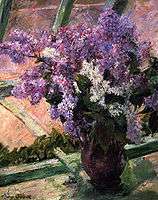 Mary Cassatt, Lilacs in a Window, 1880
Mary Cassatt, Lilacs in a Window, 1880
 John Singer Sargent, Dolce Far Niente, 1907, Brooklyn Museum
John Singer Sargent, Dolce Far Niente, 1907, Brooklyn Museum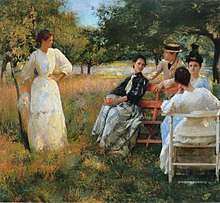 Edmund C. Tarbell, In the Orchard, 1891, Smithsonian American Art Museum, Washington, DC.
Edmund C. Tarbell, In the Orchard, 1891, Smithsonian American Art Museum, Washington, DC.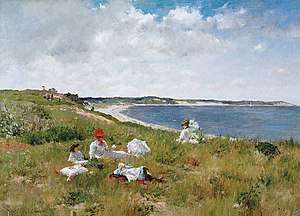 William Merritt Chase, Idle Hours, 1894, Amon Carter Museum, Fort Worth, Texas
William Merritt Chase, Idle Hours, 1894, Amon Carter Museum, Fort Worth, Texas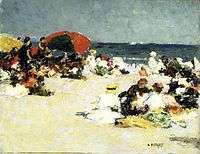 Edward Henry Potthast, On the Beach, c.1913, Brooklyn Museum
Edward Henry Potthast, On the Beach, c.1913, Brooklyn Museum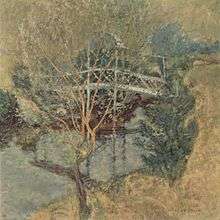 John Henry Twachtman, The White Bridge, ca. 1895, Minneapolis Institute of Arts
John Henry Twachtman, The White Bridge, ca. 1895, Minneapolis Institute of Arts J. Alden Weir, Ravine near Branchville, c. 1905–1915, Dallas Museum of Art
J. Alden Weir, Ravine near Branchville, c. 1905–1915, Dallas Museum of Art
See also
References
- Cikovsky, Jr., Nicolai (2013). "American Impressionism: Portrait of John Leslie Breck". National Gallery of Art. Retrieved 4 August 2013.
- "John Leslie Breck - Biography". Adelson Galleries. 2013. Archived from the original on 30 August 2012. Retrieved 4 August 2013.
- 1875-1943. Member of Giverny painters
- 1869-1955. Member, National Academy. http://www.tfaoi.com/aa/4aa/4aa26.htm
Sources
- Gerdts, William H. (2001). American Impressionism (Second ed.). New York: Abbeville Press Publishers. ISBN 0-7892-0737-0.
- Moure, Nancy (1998). California Art: 450 Years of Painting and Other Media. Los Angeles: Dustin Publications. ISBN 0-9614622-4-8.
- Gerdts, William H.; South, Will (1998). California Impressionism. New York: Abbeville Press. ISBN 0-7892-0176-3.
- Landauer, Susan (Editor) (1996). California Impressionists. Athens, Ga.: The Irvine Museum and Georgia Museum of Art. ISBN 0-915977-25-7.CS1 maint: extra text: authors list (link)
- Larkin, Susan G. (2001). The Cos Cob Art Colony. New York: the National Academy of Design. ISBN 0-300-08852-3.
- Weinberg, Barbara H. (2004). Childe Hassam: American Impressionist. New York: The Metropolitan Museum of Art. ISBN 1-58839-119-1.
- Westphal, Ruth Lilly (Editor) (1986). Plein Air Painters of California: The North. Irvine, Calif.: Westphal Publishing. ISBN 0-9610520-1-5.CS1 maint: extra text: authors list (link)
- Westphal, Ruth Lilly (Editor) (1982). Plein Air Painters of California: The Southland. Irvine, Calif.: Westphal Publishing. ISBN 0-9610520-0-7.CS1 maint: extra text: authors list (link)
- Peterson, Brian H. (Editor) (2002). Pennsylvania Impressionism. Philadelphia: James A. Michener Art Museum and University of Pennsylvania Press. ISBN 0-8122-3700-5.CS1 maint: extra text: authors list (link)
External links
- American Paintings in The Metropolitan Museum of Art, a fully digitized 3 volume exhibition catalog
- American impressionism and realism : a landmark exhibition from the Met, a 1991 exhibition catalog from the Metropolitan Museum of Art libraries
- smARThistory: Cassatt's The Cup of Tea
- Weir Farm:Home of an American Impressionist, a National Park Service Teaching with Historic Places (TwHP) lesson plan
- Impressionism at the Smithsonian American Art Museum
- "The Artist's Garden: American Impressionism," Exhibition on Screen
- "American Impressionism," Florence Griswold Museum
- "American Impressionism of the Late 1800s and early 1900s," National Gallery of Art
- "American Impressionism," The Met Museum
- "Finding Beauty in Land," The New York Times
